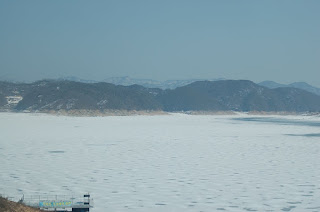Plans, plans, plans. Why do I make them? I think I will buy a ouija board and let it guide my travels. We drove up to Andong to see the mask museum, the same reason we drove there the first time, and to see two other folk villages. Instead, we ended up at a place called Dosan Seowon, a Confucian Acadamy established in 1574. This happened because the other place we were looking for had one name on the internet, and another name on the signs. We figured this out as we were leaving, of course. But now we know, and we learned that 'maeul' is the Korean transliteration for 'village', although I'm sure I don't know how to pronounce it correctly.
So after a couple of scenic photo stops, we stopped at Dosan Seowon to check it out. A former Confucian Acamdemy, Matt couldn't help but quote some "Confucious say" jokes. It had snowed here recently and the path was muddy and slushy. Mud + 4 year old = mess. We stoically trudged on and threw a few snowballs in the outside grounds. Then we went in the gate to the academy grounds. The whole 'complex' would probably fit inside an over sized American suburban lot, so it wasn't too big. Nothing exciting to talk about. The most notable thing to say about it is it used to be on the back of the 1000 won bill, but was replaced in 2007 by a picture of some beach cliffs, I don't know where they are. I'm pretty sure most of the buildings in Dosan Seowon have been repaired so much that few, if any, of the original structure remains. There is a sign hanging from the lecture hall that is supposed to be the original sign, but its condition looked too good to me to believe that. The most interesting things to me were some ancient trees that I thought were beautiful and a neat little building set apart across the river called Cheongwangunyeongdae in English. The sign says it was "the place of nature experience which was constructed to awake the profound meaning of nature and to also speculate on the mysterious truth of nature."
 |
| Dosan Seowon |
 |
| overlooking the roofs |
 |
| aerial view; it's not as big as it looks |
 |
| ancient tree; notice how they have the branches supported |
 |
| Cheongwangunyeongdae |
Nothing special really. But the drive there was amazing. I saw a frozen lake for the first time in my life. I thought it was cool. We also saw a frozen waterfall which was amazing.



I'm always disappointed when I post the pictures because the real thing is so much more impressive.
We did do at least one thing I had planned, which was the Andong Folk Museum. It was a history of what life used to be like in the Andong area showing customs related to marriage, coming of age, children, typical daily life, and death. They used to mannequins to depict most things. There was one scene depicting childbirth (the new mother was covered) but they had a sickle lying there, which is rather frightening when related to birth. According to the sign, scissors were used to cut the cord for a girl and the sickle for a boy. There was a reason, but I don't remember. I also learned that when a woman got married, she moved to her husband's house, of course, where the mother-in-law then moved to a different part and the new wife became the new 'manager'. Then when she had children, the mother-in-law/grandmother cared for the children while the wife/mother continued the household duties. Men and women lived in separate quarters, which begs the question where did the babies come from? Traditional Korean homes are built with a gate around them (we would call it a wall) that the women were not allowed to leave, which is why one of the words for wife,
anae, means "inside person". Sounds like a fun life, huh? They were allowed to leave twice a year for a ladies picnic, no men allowed. Probably the highlight of their life!

The above is a traditional wedding ceremony. It is composed of two parts, the first, called
sorye is simply the groom presenting a wooden duck to the brides father and pledging to be faithful to his bride all his life. The above part,
taerye, is conducted in the bride's parents yard. On the far left behind the 'person' in red is the wedding sedan, which is a little tiny box the bride rode in to the ceremony. The table in the center is set in a special way which differs from region to region, and sometimes family to family.
 |
| Andong Folk Village |










No comments:
Post a Comment